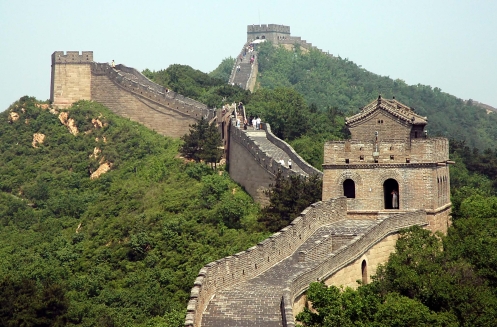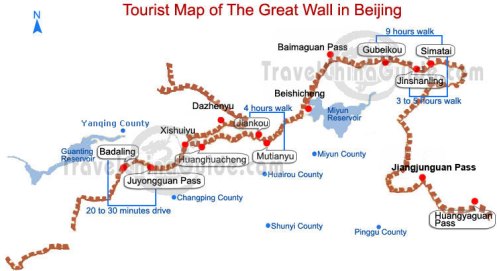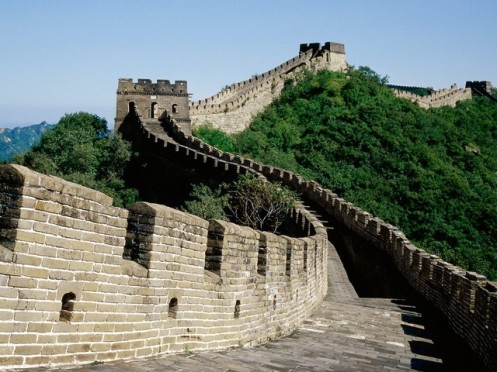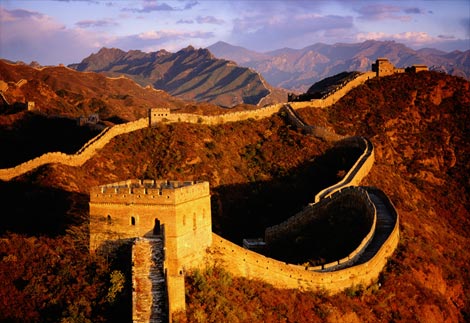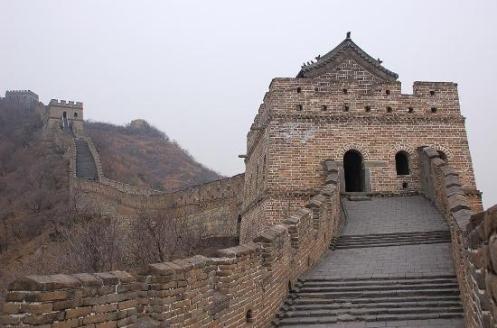The Great Wall
The Great Wall of China is a series of stone and earthen fortifications in northern China, built originally to protect the northern borders of the Chinese Empire against intrusions by various nomadic groups. Several walls have been built since the 5th century BC that are referred to collectively as the Great Wall, which has been rebuilt and maintained from the 5th century BC through the 16th century. One of the most famous is the wall built between 220–206 BC by the first Emperor of China, Qin Shi Huang. Little of that wall remains; the majority of the existing wall was built during the Ming Dynasty.
The first chapter in the history of the Great Wall of China ended in 207 BC, when the last of more than 6 billion cubic meters of compacted earth was created in its place. The Great Wall was only moderately effective in achieving its purpose, even after being confronted with bricks and stones. Its real value came in the form facilitated transport across the country, acting as a sort of freeway high, equipment, goods and passengers could more easily traverse the mountainous desert arduous involving the Great Wall.
The Great Wall stretches from Shanhaiguan in the east, to Lop Nur in the west, along an arc that roughly delineates the southern edge of Inner Mongolia. The most comprehensive archaeological survey, using advanced technologies, has concluded that the entire Great Wall, with all of its branches, stretches for 8,851.8 km (5,500.3 mi). This is made up of 6,259.6 km (3,889.5 mi) sections of actual wall, 359.7 km (223.5 mi) of trenches and 2,232.5 km (1,387.2 mi) of natural defensive barriers such as hills and rivers.
Strange as it seems now, before a Great Wall of China tour was a prerequisite of any trip to the country, many of the sections fell into disrepair over time, imports declined as the imposing structure marauding nomads scattered in the annals of time. The history of the Great Wall of China, and his return to work was really the significance of the tourism industry – now there are plenty of popular sites, where the traveler can enjoy the day one of the world’s most famous landmarks.
Badaling, Mutianyu and Simatai are the most popular places to be visiting the Great Wall of China. The closest to Beijing, where most travelers approaching is Badaling, about 40 miles northwest of the capital. This is certainly the most popular place for tour guides and those who give a cursory glance at the Great Wall. Here you will find an abundance of souvenir shops, restaurants, cheese and a host of other tourist traps, but for those who want to keep your transportation simple and convenient, this is the best place to learn the history of the Great Wall of China – The Great Wall Museum is also here.
Mutianyu is not much better. More than 50 miles from Beijing, you will find a similar environment-based tourism at Mutianyu, although the wall is much more complex than in Badaling, as you will find a series of watchtowers fascinating and some of the best views along any section of the wall.
Experienced travelers know that near the small town of Gubeikou, Simatai are the remains of one of the best places to get a free look more authentic and Watchmen line the walls, flying your way aimlessly through the countryside. The only problem with that is Simatai hike is a much more accurate to view the Wall – the strips of land with steep slopes to sharp, almost without warning, so it certainly is not for beginning hikers. But those who make the trip to Simatai sure to be rewarded with the best view of all of China.
Sure, there are plenty of different places to start your tour to the Great Wall of China itself. Other important sites are Juyong Pass and Jinshanling and Huanghua, the last feature to be considered the best preserved part of the wall around Beijing.
China Great Wall or the Great Wall of China,also known in China by the name Throughout the Great Wall of 10,000 Li, is the longest building evercreated by humans, is located in the People’s Republic of China. Length of 6400 kilometers, from Sanhai Pass area in the east to Lop Nur in the west, and the height of 8 meters denagan aim to prevent the incursion of the Mongols from the north at that time. Width the top 5 m, while the bottom width 8 m. Every 180-270 m made Such watchtower. 11-12 meter high watchtower.To create a giant wall, it takes hundreds of years in the age of variousemperor. Originally, it was estimated that Qin Shi-huang begin construction of the wall, but according to the research literature, history and records, the wall was already made before the Qin Dynasty standing, precisely constructed first on the Age of Fighting Countries. Emperor Qin Shi-huang continue development and strengthening the wall that was built previously. After the death of Qin Shi-huang, making this wall had been halted and only resumed back in the Sui Dynasty, the last was continued again at the time of the Ming Dynasty. The Great Wall which we now see is the result of development of the Sun earlier era. The inside of the wall containing soil mixed with bricks and rocks. Part it made the main road for China horsemen. Great Wall of China is regarded as one of the Seven Wonders of the World. In 1987, the building is included in the list of UNESCO World Heritage Site.
Note:
10,000 li = 5760 km. In Chinese, the number 10,000 is usually considered figuratively
as “unlimited”, so the number should actually mean “wall
whose length is infinite. “

